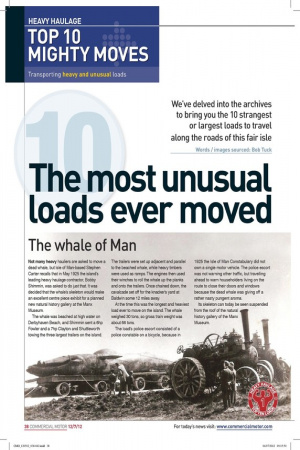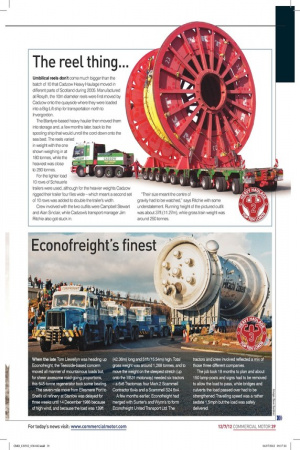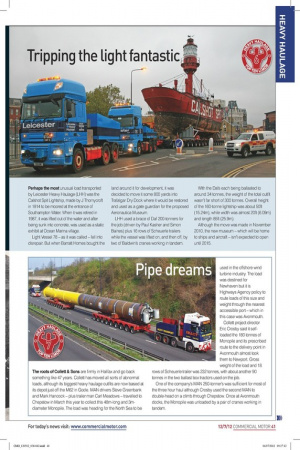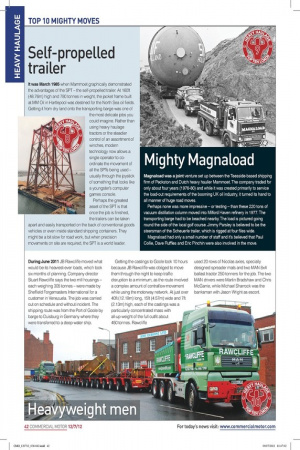10 The most unusual
Page 31

Page 32

Page 33

Page 34

Page 35

If you've noticed an error in this article please click here to report it so we can fix it.
loads ever moved
We’ve delved into the archives to bring you the 10 strangest or largest loads to travel along the roads of this fair isle
Words / images sourced: Bob Tuck
The whale of Man
Not many heavy hauliers are asked to move a dead whale, but Isle of Man-based Stephen Carter recalls that in May 1925 the island’s leading heavy haulage contractor, Bobby Shimmin, was asked to do just that. It was decided that the whale’s skeleton would make an excellent centre piece exhibit for a planned new natural history gallery at the Manx Museum.
The whale was beached at high water on Derbyhaven Beach, and Shimmin sent a 6hp Fowler and a 7hp Clayton and Shuttleworth towing the three largest trailers on the island. The trailers were set up adjacent and parallel to the beached whale, while heavy timbers were used as ramps. The engines then used their winches to roll the whale up the planks and onto the trailers. Once chained down, the cavalcade set off for the knacker’s yard at Baldwin some 12 miles away.
At the time this was the longest and heaviest load ever to move on the island. The whale weighed 30 tons, so gross train weight was about 66 tons.
The load’s police escort consisted of a police constable on a bicycle, because in 1925 the Isle of Man Constabulary did not own a single motor vehicle. The police escort was not warning other traffic, but travelling ahead to warn householders living on the route to close their doors and windows because the dead whale was giving off a rather nasty pungent aroma.
Its skeleton can today be seen suspended from the roof of the natural history gallery of the Manx Museum.
The reel thing...
Umbilical reels don’t come much bigger than the batch of 10 that Cadzow Heavy Haulage moved in different parts of Scotland during 2005. Manufactured at Rosyth, the 10m diameter reels were first moved by Cadzow onto the quayside where they were loaded into a Big Lift ship for transportation north to Invergordon.
The Blantyre-based heavy haulier then moved them into storage and, a few months later, back to the spooling ship that would unroll the cord down onto the sea bed. The reels varied in weight with the one shown weighing in at 180 tonnes, while the heaviest was close to 280 tonnes.
For the lighter load 10 rows of Scheuerle trailers were used, although for the heavier weights Cadzow rigged their trailer four files wide – which meant a second set of 10 rows was added to double the trailer’s width.
Crew involved with the two outfits were Campbell Stewart and Alan Sinclair, while Cadzow’s transport manager Jim Ritchie also got stuck in. “Their size meant the centre of gravity had to be watched,” says Ritchie with some understatement. Running height of the pictured outfit was about 37ft (11.27m), while gross train weight was around 250 tonnes.
Econofreight’s finest
When the late Tom Llewellyn was heading up Econofreight, the Teesside-based concern moved all manner of mountainous loads but, for sheer awesome road-going proportions, this 645-tonne regenerator took some beating.
The seven-mile move from Ellesmere Port to Shell’s oil refinery at Stanlow was delayed for three weeks until 14 December 1986 because of high wind, and because the load was 139ft (42.36m) long and 51ft (15.54m) high. Total gross weight was around 1,268 tonnes, and to move the weight on the steepest stretch (up onto the M531 motorway) needed six tractors – a 6x6 Tractomas; four Mark 2 Scammell Contractor 6x4s and a Scammell S24 6x4.
A few months earlier, Econofreight had merged with Sunter’s and Wynn’s to form Econofreight United Transport Ltd. The tractors and crew involved reflected a mix of those three different companies.
The job took 18 months to plan and about 150 lamp-posts and signs had to be removed to allow the load to pass, while bridges and culverts the load passed over had to be strengthened. Travelling speed was a rather sedate 1.5mph but the load was safely delivered.
Bradwell and the Rotinoff
May 1958 was a memorable time in the heavy haulage calendar because of what took place on the banks of the River Blackwater in Essex. When the Teesside-based heavy engineering concern of Head Wrightson won an order to supply 12 boilers – each 92ft (28.04m) long, 22ft (6.7m) in diameter and weighing 235 tons – for the Bradwell power station in Essex, the plan was for them to be towed down the North Sea by tug. They were to be transferred to dry land using the falling tide to allow the boiler to drop exactly onto a trailer strategically placed on a slipway before the tide came in.
Pickfords Heavy Haulage apparently turned down the job because it didn’t want its solid tyre bogies to get covered in sea water, but Sunter Bros of Northallerton rose to the occasion and took the job on.
Tom Sunter went to the long-established Cranes of Dereham to buy a set of 200-ton capacity bogies but opted for buying an untested Rotinoff Atlantic to pull the dead mass up the 1in-10 slipway and transport the boilers the 1.5 miles into the power station.
Moving the first boiler was a nail biting time and three Rotinoff Atlantic 6x4 tractors were used to pull it up the slipway. On the flat, the two leading tractors (which were supplied direct from the Rotinoff factory) were unhitched and Sunter driver John Robinson made the run unaided. This one job (which lasted 18 months in total) made Sunter’s reputation – and that of its driver John Robinson. However, after George Rotinoff’s subsequent sudden death, production of his fantastic Atlantic tractor quietly ceased.
Crawling speed
Before tyre technology and modular axle construction caught up with the demands of the ultra heavy moving world, operators had to be more inventive in the way they did things – on dry land at least. Crawlers had long been in use as base units for the heaviest type of mobile cranes in service, so during the early 1970s Rigging International was one firm that specialised in offering this type of machinery for site work. Obviously, travelling speed was fairly slow and the potential damage to the road surface was very high.
But the crawlers did get the job done, which was no mean feat when load weights were close to 1,000 tonnes.
Tripping the light fantastic
Ed min utpat. Ugue dolore mgna at Onse ming eugait irliuis au et auat autem ea facipsusci aute ver alismodip eum ero dolor se feugiate t utet Perhaps the most unusual load transported land iriuscin hendiam, core velit aliquat. Ut nisl et, vel by Leicester Heavy Haulage (LHH) was the deci Calshot Spit Lightship, made by J Thornycroft dip exerit in volore ming eugiam t inisi blam aestrud Trafalg ming erostrud te faccummy null u fa uer ing in 1914 to be moored at the entrance of and u Southampton Water. When it was retired in er se diam iureet nos dolutpatuero consed feugiam Aerona ad dun adio dunt nim il ut aliquipisim dol 1987, it was lifted out of the water and after being sunk into concrete, was used as a static
XXXX
exhibit at Ocean Marina village.
Light Vessel 78 – as it was called – fell into disrepair. But when Barratt Homes bought the around it for development, it was ded to move it some 800 yards into ar Dry Dock where it would be restored sed as a gate guardian for the proposed utica Museum.
LHH used a brace of Daf 200-tonners for the job (driven by Paul Kasher and Simon Baines) plus 16 rows of Scheuerle trailers while the vessel was lifted on, and then off, by two of Baldwin’s cranes working in tandem. With the Dafs each being ballasted to around 34 tonnes, the weight of the total outfit wasn’t far short of 300 tonnes. Overall height of the 160-tonne lightship was about 50ft (15.24m), while width was almost 20ft (6.09m) and length 85ft (25.9m).
Although the move was made in November 2010, the new museum – which will be home to ships and aircraft – isn’t expected to open until 2015.
Pipe dreams
The roots of Collett & Sons are firmly in Halifax and go back something like 47 years. Collett has moved all sorts of abnormal loads, although its biggest heavy haulage outfits are now based at its depot just off the M62 in Goole. MAN drivers Steve Greenbank and Mark Hancock – plus trailer man Carl Meadows – travelled to Chepstow in March this year to collect this 48m-long and 3mdiameter Monopile. The load was heading for the North Sea to be used in the offshore wind turbine industry. The load was destined for Newhaven but it is Highways Agency policy to route loads of this size and weight through the nearest accessible port – which in this case was Avonmouth.
Collett project director Eric Crosby said it selfloaded the 180 tonnes of Monopile and its prescribed route to the delivery point in Avonmouth almost took them to Newport. Gross weight of the load and 18 rows of Scheuerle trailer was 232 tonnes, with about another 90 tonnes in the two ballast box tractors used on the job.
One of the company’s MAN 250-tonner’s was sufficient for most of the three hour haul although Crosby used the second MAN to double-head on a climb through Chepstow. Once at Avonmouth docks, the Monopile was unloaded by a pair of cranes working in tandem.
Self-propelled trailer
ft was March 1985 when Mammoet graphically demonstrated the advantages of the SPT – the self-propelled trailer. At 160ft (48.76m) high and 780 tonnes in weight, the jacket frame built at MM Oil in Hartlepool was destined for the North Sea oil fields. Getting it from dry land onto the transporting barge was one of the most delicate jobs you could imagine. Rather than using heavy haulage tractors or the steadier control of an assortment of winches, modern technology now allows a single operator to coordinate the movement of all the SPTs being used – usually through the joystick of something that looks like a youngster’s computer games console.
Perhaps the greatest asset of the SPT is that once the job is finished, the trailers can be taken apart and easily transported on the back of conventional goods vehicles or even inside standard shipping containers. They might be a bit slow for road work, but when precision movements on site are required, the SPT is a world leader.
Mighty Magnaload
Magnaload was a joint venture set up between the Teesside-based shipping firm of Peckston and Dutch heavy haulier Mammoet. The company traded for only about four years (1976-80) and while it was created primarily to service the load-out requirements of the booming UK oil industry, it turned its hand to all manner of huge road moves.
Perhaps none was more impressive – or testing – than these 220 tons of vacuum distillation column moved into Milford Haven refinery in 1977. The transporting barge had to be beached nearby. The load is pictured going round the side of the local golf course. Jimmy Parsley is believed to be the steersman of the Scheuerle trailer, which is rigged at four files wide.
Magnaload had only a small number of staff and it’s believed that Paul Collie, Dave Ruffles and Eric Pinchin were also involved in the move.
Heavyweight men
During June 2011 JB Rawcliffe moved what would be its heaviest-ever loads, which took six months of planning. Company director Stuart Rawcliffe says the two mill housings – each weighing 305 tonnes – were made by Sheffield Forgemasters International for a customer in Venezuela. The job was carried out on schedule and without incident. The shipping route was from the Port of Goole by barge to Duisburg in Germany where they were transferred to a deep water ship. Getting the castings to Goole took 10 hours because JB Rawcliffe was obliged to move them through the night to keep traffic disruption to a minimum, as the route involved a complex amount of contraflow movement while using the motorway network. At just over 40ft (12.19m) long, 15ft (4.57m) wide and 7ft (2.13m) high, each of the castings was a particularly concentrated mass with all-up weight of the full outfit about 450 tonnes. Rawcliffe used 20 rows of Nicolas axles, specially designed spreader mats and two MAN 8x4 ballast tractor 250-tonners for the job. The two MAN drivers were Martin Bradshaw and Chris McGarrie, while Michael Sharrock was the banksman with Jason Wright as escort.











































